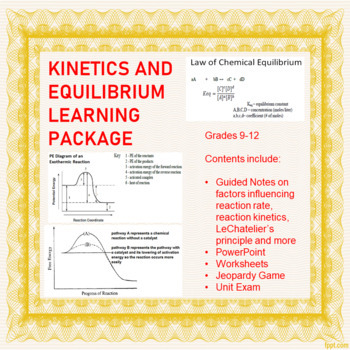Kinetics and Equilibrium Learning Package (Distance Learning)
- Zip
- Easel Assessment
Description
This zip file contains many different activities (48 pages of student handouts and PowerPoints with a total of 106 slides) which can be used to compose a unit for chemistry students introducing concepts pertaining to kinetics and equilibrium. While these lessons were originally designed to correlate to the performance indicators of the New York State Chemistry - Physical Setting curriculum, the components of this lesson may be easily used in other chemistry or physical science courses as well. The components this unit addresses in the NGSS Standards and Common Core Standards are indicated at the end of this description.
Some of the topics addressed in this learning packet include potential energy diagrams, heat of reaction, factors influencing reaction rate, equilibrium expressions, enthalpy/entropy and Le Chatelier's Principle.
Many documents are included in both word docx as well as pdf format to allow editing for specific teacher needs. These documents are well suited for use in distance learning environments.
The specific contents of the learning package includes the following items (the page count for these items are actual student handouts as answer key page counts are not included):
- Marzano self assessment scale including learning goals and Common Core Reading/Writing and Mathematics Standards for students specific to this unit (2 pp.)
- Learning Objectives Including NGSS and Common Core (2 pp.)
- Scaffolded Completion notes handout for students (13 pp.)
- 47 slide PowerPoint to accompany the scaffolded completion notes
- Factors Influencing the Rate of a Chemical Reaction Lab (3 pp.)
- Potential Energy Diagram Worksheet with key (4 pp.) (20 questions)
- Heat of Reaction Worksheet with answer key (15 questions) (2 pp.)
- Heat of Reaction Reference Table (1 p.)
- Factors Influencing Reaction Rate Worksheet with answer key (4 pp.) (13 questions)
- Equilibrium and Le Chatelier's Worksheet with answer key (6 pp.) (23 questions)
- Entropy and the Common Ion Effect with key (3 pp.) (12 questions)
- Kinetics and Equilibrium Unit Exam with key (12 pp.) (50 questions)
- Kinetics and Equilibrium Jeopardy Review Game in PowerPoint format (26 questions) (54 slides)
Bundle and Save!!
This learning package is part of the Complete High School Chemistry Course. Save time and money with the purchase of the Complete High School Chemistry Course! The complete course contains 12 Chemistry Units, as well as the Crash Course Chemistry Video Worksheet Guides. The Complete High School Chemistry Course is available for $27.99. This is a savings over 50% if each component in the Chemistry Complete Course was purchased individually. The units covered in the complete course can be viewed here.
Learning Goals
Upon the completion of this unit the student will be able to:
1. explain what is meant by the term reaction kinetics.
2. list two ways reaction rate can be measured.
3. explain what is meant by a reaction mechanism and recognize this often involves multiple steps.
4. define the terms activation energy, heat of reaction, and activated complex.
5. interpret potential energy diagrams, being able to determine the following; PE of reactants, PE of products, PE of activated complex, activation energy for the forward or reverse reaction, and the heat of reaction for the forward or reverse reaction.
6. distinguish between endothermic and exothermic reactions, using energy terms in a reaction equation, ∆H, potential energy diagrams or experimental data.
7. use collision theory to explain how various factors, such as temperature, surface area and concentration, influence the rate of reaction.
8. identify examples of physical equilibria as solution equilibrium and phase equilibrium, including the concept that a saturated solution is at equilibrium.
9. describe the concentration of particles and rates of opposing reactions in an equilibrium system.
10. understand how to determine the equilibrium constant and what a large or
small equilibrium constant tells us about the concentration of the product and reactants.
11. state Le Chatelier’s principle and describe the effects of the following yypes of stresses on the reaction system; increased concentration of reactants or products, increased temperature, changes in temperature and the influence of a catalyst.
12. utilize the principle of common ion effect to determine how equilibria will shift in response to additional compounds.
13. define the term enthalpy and be able to determine if a reaction is spontaneous by looking at enthalpy, entropy, and temperature.
NGSS Standards
HS-PS1-5. Apply scientific principles and evidence to provide an explanation about the effects of changing the temperature or concentration of the reacting particles on the rate at which a reaction occurs.
HS-PS1-6. Refine the design of a chemical system by specifying a change in conditions that would produce increased amounts of products at equilibrium.
Common Core State Standards Connections:
ELA/Literacy
WHST.9-12.2 Write informative/explanatory texts, including the narration of historical events, scientific procedures/ experiments, or technical processes.
Mathematics
MP.2 Reason abstractly and quantitatively.
HSN-Q.A.1 Use units as a way to understand problems and to guide the solution of multi-step problems; choose and interpret units consistently in formulas; choose and interpret the scale and the origin in graphs and data displays.
HSN-Q.A.2 Define appropriate quantities for the purpose of descriptive modeling.
HSN-Q.A.3 Choose a level of accuracy appropriate to limitations on measurement when reporting quantities.
Terms of Use
Purchase of the product is for classroom use by the purchaser only. It is a violation for individuals, schools, and districts to redistribute or sell this item on the Internet or to other individuals. I do encourage you to use and edit these documents to suit your needs with your own students in distance learning environments.
This work is licensed under a Creative Commons Attribution-NonCommercial-ShareAlike 4.0 International License.






